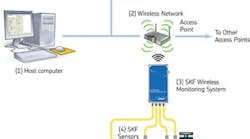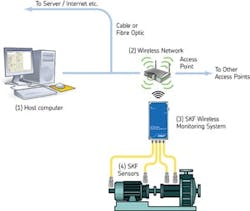Case Study: Online Monitoring Pays Off
Gulf Chemical processes spent petroleum catalysts from oil refineries. The company, a subsidiary of the Eramet Group, is the world’s largest recycler of such catalysts and a leading producer of ferroalloys. It’s the only firm that applies hydrometallurgical and pyrometallurgical operations to recover molybdenum, vanadium, nickel and cobalt for reuse by major catalyst producers and steel makers.
The company has embarked on a strategic mission to achieve sustained reliability objectives for rotating machinery and, in turn, optimize cost avoidance at its Freeport, Texas, facility. And it reckoned that wireless online condition monitoring could play a crucial role. After all, the technology offers benefits such as 24/7 capability to watch equipment and upload data for analysis, and a centralized data repository accessible to management and staff regardless of their locations.
In line with the initiative, Gulf Chemical auditioned and then expanded a sophisticated wireless condition monitoring system from SKF Reliability Systems, San Diego. The process began in late 2007 with a limited trial and ultimately led to deployment of a highly advanced online system to monitor dozens of critical assets. Total documented savings exceeded system cost within the first year.
One example of cost avoidance in action involved a bag house blower whose proper functioning and levels of throughput are essential for meeting U.S. environmental regulations. The SKF wireless online condition monitoring system was able to detect an incipient failure within the blower just in time to schedule repairs during a routine maintenance stoppage without interrupting production. This saved approximately $42,000 in costs that otherwise would have been incurred for materials, rebuilds from total degradation, overtime and production downtime.
Taking First Steps
The trial focused on two problematic high-output fans. First-pass troubleshooting pointed to design flaws with their base structures as the apparent cause of repeated fan failures. A massive (and costly) redesign of each base was considered inevitable.
During the trial, fan operating parameters were monitored using the SKF Wireless Monitoring System V/T (Figure 1). These battery-powered eight-channel units directly mount on machines to collect data on acceleration, velocity, temperature and bearing condition, including spectral data for automatic upload for viewing and analysis. In this case, analysis of vibration data showed the base structure wasn’t the source of the problem. Instead, the plant discovered — and then verified — that cavitation in the ducting was the root cause of premature bearing (and fan) failures; this eliminated any need for a redesign of the fan base and any outlay of associated capital.
The trial’s success spurred expansion of condition monitoring throughout the facility. The critical assets now under constant online surveillance include dozens of cooling pumps, hydraulic pumps, scrubber pumps, high-volume fans and blowers, paddle mixers, electric motors and cage mills. All are monitored 24/7 by the SKF Multilog On-Line System IMx-S (Figure 2).
Mutlilog IMx-s, coupled with SKF @ptitude Observer software, enables early fault detection and prevention, offers automatic advice for correcting existing or impending conditions, and thus fosters advanced condition-based maintenance for improved machine reliability, availability and performance.
Monitoring in Action
Here’s how Gulf Chemical has implemented the system:
The SKF IMx-S technology monitors multiple components in designated critical assets. For example, the system’s dual sensors (vibration and temperature) applied to an overhung fan keep watch on two motor bearings, two shaft bearings and one tachometer using eight analog channels and one digital channel. Data are wirelessly transmitted within a 100 ft. radius to a strategically located wireless network point in the plant.
Each sensor in the drive train has a predetermined warning and caution threshold. A simple visual “stop light” indicator (red for warning, yellow for caution and green for normal) appears on the system’s graphical interface on LCD screens in the reliability offices and the operations digital control center. When a threshold is exceeded, the indicator turns yellow or red; an overview screen pinpoints the source and allows a reliability technician to access a photo layout of the actual asset with stop light indicators showing temperature and overall inches-per-second parameters. This allows the person to quickly identify the questionable part of the rotating assembly.
The system enables all relevant parties to be brought up to speed in a timely manner regardless of their location. The supervisor and maintenance foreman for the area where the equipment is operating as well as the reliability and maintenance superintendents simultaneously receive e-mails.
After confirming via a handheld monitoring unit that online data are correct, the reliability department performs both a complete amplitude and phase analysis on the failure and creates a work order for maintenance that gives appropriate actions that need to be taken to address the problem. Once corrective work is complete, a reliability specialist takes data to check the adequacy of the repair and that the initial failure wasn’t masking other issues.
Total time elapsed from the initial warning to repair and verification depends upon the size of the equipment and severity of the problem but usually is less than 12 hours.
The @ptitude Observer software serves as the primary HMI (human/machine interface) for asset failure notification; its simplicity has made life easier for management and the workforce. The stop light indicators allow an operator without any experience in vibration monitoring to identify deviations from normal operating condition. The operator clicks on an auto analysis tab and reads the analysis report to learn what’s wrong, and then notifies maintenance staff for remedial action.
The system’s unique built-in hardware auto-diagnostics continuously check all sensors, cabling and electronics for any faults, signal interruption, electrical shorts or power failures. Any malfunctions will trigger an alarm; in the case of power failure, the system automatically restarts when the power returns.
For Gulf Chemical the system has fully supported condition-based maintenance objectives while providing measurable economies by reducing the time and staffing required to analyze a deviation from operating norms.
The SKF system has helped end the need for multiple employees to run routes, shortened the time required to analyze data, and minimized risks of potential equipment failures due to excessive time between notification and correction. In addition, mechanics in the field now can call on a radio or cell phone to receive accurate data about repairs within seconds without waiting.
Top management and reliability staffs at Gulf Chemical understood at the outset that a proactive approach toward maintenance in partnership with an experienced and innovative supplier could generate improved performance, reliability, economy and service life of critical assets. The Freeport facility’s experience has proven this and has cast Gulf Chemical and SKF as partners in progress.
Casey A. Connolly is continuous improvement manager for Gulf Chemical & Metallurgical Corp., Freeport, Texas. E-mail him at [email protected]. Frank Mignano is senior account manager at SKF Reliability Systems, Houston. E-mail him at [email protected].




